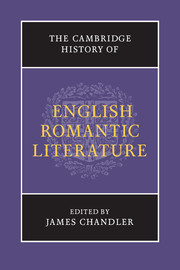Book contents
- Frontmatter
- Introduction
- Part I The Ends of Enlightenment
- Part II Geographies: The Scenes of Literary Life
- 5 London in the 1790s
- 6 Edinburgh and Lowland Scotland
- 7 Romantic Ireland: 1750–1845
- 8 France, Germany, America
- 9 The ‘warm south’
- 10 Country matters
- 11 Romanticism and the wider world: poetry, travel literature and empire
- 12 The homes of England
- 13 Writing, reading and the scenes of war
- 14 Regency London
- Part III Histories: Writing in the New Movements
- Part IV The Ends of Romanticism
- Chronology
- Bibliographies
- Index
- 1 A New Pocket Map of the Cities of London and Westminster; with the Borough of Southwark, Comprehending the new Buildings and other Alterations, 3rd edn (London: William Faden, 1790).">
- References
7 - Romantic Ireland: 1750–1845
from Part II - Geographies: The Scenes of Literary Life
Published online by Cambridge University Press: 28 May 2009
- Frontmatter
- Introduction
- Part I The Ends of Enlightenment
- Part II Geographies: The Scenes of Literary Life
- 5 London in the 1790s
- 6 Edinburgh and Lowland Scotland
- 7 Romantic Ireland: 1750–1845
- 8 France, Germany, America
- 9 The ‘warm south’
- 10 Country matters
- 11 Romanticism and the wider world: poetry, travel literature and empire
- 12 The homes of England
- 13 Writing, reading and the scenes of war
- 14 Regency London
- Part III Histories: Writing in the New Movements
- Part IV The Ends of Romanticism
- Chronology
- Bibliographies
- Index
- 1 A New Pocket Map of the Cities of London and Westminster; with the Borough of Southwark, Comprehending the new Buildings and other Alterations, 3rd edn (London: William Faden, 1790).">
- References
Summary
One of the emblematic moments of Irish Romanticism occurs in Sydney Owenson’s pioneering novel, The Wild Irish Girl (1806), when Horatio, a jaded libertine, travels from London to the west of Ireland in pursuit of primitive simplicity and the noble savage, only to find that the natives are already reading Rousseau. The Wild Irish Girl can be seen as ushering in the ‘myth of the West’ of Ireland that was to preside over Irish Romanticism and, indeed, the images of the western seaboard promulgated by W. B. Yeats and John Millington Synge during the Literary Revival at the turn of the twentieth century. Central to this romantic vision was the idea that the further west one travelled – whether to Kerry, Connemara or Sligo – the more one came into contact with the ‘real’ Ireland, uncontaminated by the influence of the city or, at another remove, empire. Yet from the outset, Romantic Ireland contained within itself its own counter-currents, at once staging and contesting the ‘images for the affections’ (in Yeats’s phrase) that drew countless visitors and travellers to the periphery. In Lady Morgan’s novel, well-stocked libraries in crumbling castles compete with the awe-inspiring scenery for the attention of local inhabitants, and Glorvina, the daughter of a Gaelic chieftain and eponymous heroine of the novel, is as attuned to debates in the Enlightenment salons of mainland Europe as she is to the ‘woodnotes wild’ of her Irish harp.
Keywords
- Type
- Chapter
- Information
- The Cambridge History of English Romantic Literature , pp. 182 - 203Publisher: Cambridge University PressPrint publication year: 2009
References
- 1
- Cited by



